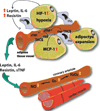Obesity and coronary microvascular disease - implications for adipose tissue-mediated remote inflammatory response
- PMID: 24846234
- PMCID: PMC4167722
- DOI: 10.2174/1570161112666140423221843
Obesity and coronary microvascular disease - implications for adipose tissue-mediated remote inflammatory response
Abstract
It is believed that obesity has detrimental effects on the coronary circulation. These include immediate changes in coronary arterial vasomotor responsiveness and the development of occlusive large coronary artery disease. Despite its critical role in regulating myocardial perfusion, the altered behavior of coronary resistance arteries, which gives rise to coronary microvascular disease (CMD) is poorly understood in obesity. A chronic, low-grade vascular inflammation has been long considered as one of the main underlying pathology behind CMD. The expanded adipose tissue and the infiltrating macrophages are the major sources of pro-inflammatory mediators that have been implicated in causing inadequate myocardial perfusion and, in a long term, development of heart failure in obese patients. Much less is known the mechanisms regulating the release of these cytokines into the circulation that enable them to exert their remote effects in the coronary microcirculation. This mini review aims to examine recent studies describing alterations in the vasomotor function of coronary resistance arteries and the role of adipose tissue-derived pro-inflammatory cytokines and adipokines in contributing to CMD in obesity. We provide examples of regulatory mechanisms by which adipokines are released from adipose tissue to exert their remote inflammatory effects on coronary microvessels. We identify some of the important challenges and opportunities going forward.
Conflict of interest statement
The authors confirm that this article content has no conflicts of interest.
Figures

References
-
- Hall JE, Brands MW, Henegar JR. Mechanisms of hypertension and kidney disease in obesity. Ann N Y Acad Sci. 1999;892:91–107. - PubMed
-
- Schindler TH, Cardenas J, Prior JO, Facta AD, Kreissl MC, Zhang XL, et al. Relationship between increasing body weight, insulin resistance, inflammation, adipocytokine leptin, and coronary circulatory function. J Am Coll Cardiol. 2006;47(6):1188–1195. - PubMed
-
- Quercioli A, Pataky Z, Montecucco F, Carballo S, Thomas A, Staub C, et al. Coronary Vasomotor Control in Obesity and Morbid Obesity Contrasting Flow Responses With Endocannabinoids, Leptin, and Inflammation. Jacc-Cardiovasc Imag. 2012;5(8):805–815. - PubMed
-
- Vincenti GM, Ambrosio G, Hyacinthe JN, Quercioli A, Seimbille Y, Mach F, et al. Matching between regional coronary vasodilator capacity and corresponding circumferential strain in individuals with normal and increasing body weight. J Nucl Cardiol. 2012;19(4):693–703. - PubMed
Publication types
MeSH terms
Substances
Grants and funding
LinkOut - more resources
Full Text Sources
Other Literature Sources
Medical

